David Hedison '51 went to Brown to be deprogrammed. Or at least dissuaded. Hedison, a returning war veteran, had somehow gotten the idea stuck in his head that he wanted to be an actor, and his father, a Providence jeweler, told him that not only was his son not going to trip the light fantastic in New York City, he was going to apply to Brown.

"He thought that it would change my mind," Hedison recalls. The strategy didn't work, though. Hedison's father hadn't anticipated the lure of the Sock and Buskin theater group, or the draw of its soft-spoken impresario of the time, drama professor Ben Brown '19. In fact, Hedison spent most of his time on College Hill acting, mostly on the stage at Faunce House, and most memorably in the role of Proteus in The Two Gentlemen of Verona. He was so dedicated to acting, in fact, that he neglected his other classes and eventually flunked out of Brown, despite the A's he recalls earning in Ben Brown's drama class. As it happened, though, the lack of a degree didn't hamper Hedison's career much. He did make it to the bright lights and big city shortly after leaving campus and eventually studied with Lee Strasberg at the Actors Studio. Over the past half-century, Hedison, who lives in Santa Monica, California, has acted in more than 150 movies, plays, and television shows. His best-known performance is no doubt as the half-man, half-insect professor in the original 1958 version of the postnuclear sci-fi classic The Fly, which in 1998 Entertainment Weekly chose as one of its Sci-Fi 100.
And it all began with Sock and Buskin. "It was good training," Hedison says. "You could do certain things and be dreadful and do other things marvelously. And you could begin to find yourself and the roles that you play better than others."
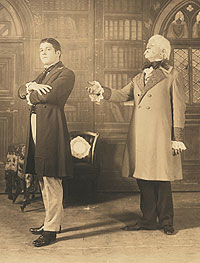
Hedison's star turn came at roughly the midpoint in the theater group's history. Sock and Buskin turned 100 this spring, and the measure of its success is found both in its most famous alumni - Alfred Uhry '58, James Naughton '67, JoBeth Williams '70, Mary Chapin Carpenter '81, John F. Kennedy Jr. '83, and Laura Linney '86, to name a few - and in the hundreds of lesser-known writers, actors, producers, and editors who have crossed its stage. But the biggest group of Sock and Buskin alumni has been those thousands of young men and women with unexceptional acting talent who got a taste of the creative world before departing for jobs on Wall Street or for a spot in medical school, whose memories of crisp Shakespearean lines mixed with those of such scandalous social events as the one described by Leslie Allen Jones '26 as "the spaghetti party in the hotel in Connecticut." Little is known about this party, which reportedly took place during the 1920s and which remains embedded in Sock and Buskin lore. Writing about it some time later, Jones, the group's longtime faculty adviser and technical director, was coyly discreet. "We will draw the curtain," he wrote.
THERE ARE OLDER collegiate theater companies around, but all are strictly student groups. What has distinguished Sock and Buskin has been its faculty-student collaboration. Guiding the students has been a series of dedicated, well-loved drama teachers, most notably Thomas Crosby Jr., Ben Brown, Janice Van De Water, and James Barnhill.

The first of these, Tom Crosby, class of 1894, was the scion of a wealthy Newport family. According to the gossip of the time, Crosby became a Brown English professor after a relative had arranged the appointment to lure him away from the socially unacceptable theater scene in New York City (a story strangely similar to Hedison's decades later). To many students, Crosby - with his rich voice, pince-nez glasses, and shock of white hair - was the archetype of an early-twentieth-century professor. But the appearances were deceiving. His life was devoted to the theater, beginning with a famous episode as an undergraduate in which, during a performance of Julius Caesar with Shakespearean legend Edwin Booth, he was trapped on stage when his toga snagged on the funeral bier.
Until Crosby created Sock and Buskin during the 1901Ð02 academic year, theater on campus was briefly dominated by the Thalian Dramatic Association, founded just after the Civil War, and then by Hammer & Tongs, whose minstrel shows and farces seem particularly dated today. (Hammer & Tongs closed up shop in 1897.) Crosby's early productions were of contemporary light works. This was in part a reflection of Crosby's taste; he was the first professor at Brown to teach modern drama and poetry and his diction classes were known for stressing a contemporary manner of speech. A dapper lifelong bachelor and bon vivant, he inspired a generation of student actors, often by example, demonstrating how to strut and how to speak. His influence over Sock and Buskin was felt as late as 1941, when he commemorated the group's fortieth anniversary by playing the role of the elderly Nathaniel Berry in James A. Herne's Shore Acres.
In the early years Brown had no campus stage, so Sock and Buskin (the name comes from the sock donned by Greek comic actors and from the sandal-like footwear worn in tragedies) performed downtown at the Providence Opera House. In those days men played all the roles, and the audience liked to, well, get involved: actors at the Opera House frequently had to dodge flour bombs tossed by unruly students celebrating a little too hard. Many early reviews seemed focused on the burly, deep-voiced actors playing the female parts; the Providence Journal referred to one as "looking very well, but when 'she' spoke, the bass voice was startling and when 'she' walked, it reminded one of a baseball player trying to make first base."
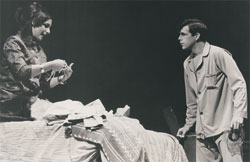
Crosby was a tough act to follow, but next up, as it were, was Ben Brown. In many ways the two men were opposites. Brown was more cerebral. He coached his actors with words rather than dramatic demonstrations, and he tended to choose more thought-provoking plays. His staying power proved even greater than Crosby's. He led Sock and Buskin for thirty-four years, from 1921 to 1955, during a period of great change in college theater. In his first decade Ben Brown steered Sock and Buskin toward a full season of productions, which meant building a permanent facility on campus and going on the road to stage popular plays as a way of paying for the money-losing experimental ones Sock and Buskin increasingly preferred on campus. In 1931, thanks to the generosity of John D. Rockefeller Jr. of the class of 1897, Sock and Buskin moved into a 360-seat theater in the newly christened Faunce House. For its debut production, Brown chose The Merchant of Venice.
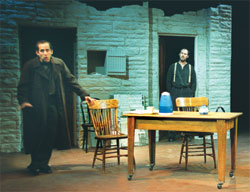
During its first quarter-century Sock and Buskin shared the limelight with a Pembroke acting group also founded in 1901. In those gender-segregated days, the Komians, as the Pembroke group was called, faced even greater societal hurdles than did their male counterparts. Not only were women required to play the male roles; University administrators forbade them from wearing men's clothes. Although Ben Brown, for all his other innovations, was at first reluctant to consummate the obvious merger of the two groups, women did start joining Sock and Buskin productions in 1931. The groups were finally combined a decade later at the onset of World War II. It was a major step forward but triggered some nostalgia for earlier "starlets." As Leslie Allen Jones opined on the group's fiftieth anniversary, "I have been told that Rufus Fuller '19, as a pink-cheeked ingenue, smoking a cigar at a rehearsal, was a sight to see."
It's impossible to overstate the influence Ben Brown had on Sock and Buskin. Alumni and faculty alike stress the role students play in selecting each season's productions, but in fact Brown was a master at subtly steering the undergrads toward the plays he wanted to produce anyway. The urging usually came over small dinners at the Spaghetti House, the downtown Providence restaurant where the lifelong bachelor dined almost every night. "He would take two or three of the men, go down to the Spaghetti House, and announce, 'We've decided the season,'" recalls Professor Emeritus of Theatre, Speech, and Dance James O. Barnhill, who arrived on campus in time to observe Brown's final two seasons. (Brown died suddenly at age fifty-seven of a brain hemorrhage.) "He was very open," Barnhill chuckles, "but only to what he wanted to hear."
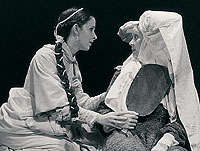
JANICE VAN DE WATER succeeded Brown in 1955. An expert in Shakespeare and in technical direction, she was one of the first women to guide a major college theater program. She appeared to be on the verge of a long career when multiple sclerosis forced her to step down in 1963. (She died in 1999.) "She was a very meticulous woman," says Barnhill, who succeeded her. "She was at her best doing period plays in the style of 1700 through 1900." Barnhill recalls the 1950s and 1960s as an era when the Sock and Buskin acting was excellent but the productions had an amateur feel. (Production Workshop began in 1959Ð60 as a less time-consuming alternative.) When the Faunce House theater began doubling as a movie house, fights broke out between thespians and the building's supervisors over use of the facilities. Such basics as costume and set design had to be obtained off campus. "There was a place called Hooker and Howell in Lowell, Massachusetts," Barnhill remembers. "We'd send all the measurements up there, and they'd send us back the costumes."
The cultural crosscurrents of the 1960s and 1970s made staying ahead of fast-moving events more difficult, and student interest in Sock and Buskin began to lag. (Rites and Reason was founded in 1970 as the theater-arts component of Afro-American studies.) Things picked up again after the theater program, long an offshoot of English, became its own department in 1978. "For a long time, Brown theater struggled," explains Don Wilmeth, who chaired the theatre, speech, and dance department on and off in the 1980s and 1990s. "The faculty was small. There was not much University support for the arts, and theater facilities were really crummy. Now our faculty is as good as any university. Things have really changed in the last forty years."
As Brown theater came into its own, the University began turning out increasingly celebrated actors and directors. An early standout was Richard Foreman '59, who gave a memorable performance for Sock and Buskin in Death of a Salesman and who went on to become a giant of American experimental theater. Later came two-time Tony award winner James Naughton and JoBeth Williams, who starred in the baby-boomer classic The Big Chill.
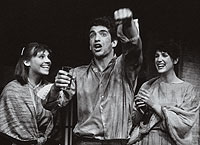
Among Sock and Buskin alumni from the 1980s is Laura Linney, who arrived at Brown in love with theater, particularly with working behind the scenes. "I had a real yearning to be involved, not to be a star," she told the Brown Daily Herald in 1998. "I loved the buildings, the community that theater provided, the work ethic. I loved the history of it." It was with Sock and Buskin that Linney discovered the skill that would later land her starring roles in such major motion pictures as The Truman Show and You Can Count on Me, for which she earned an Academy Award nomination. She immersed herself in theater classes and, in addition to her work with Sock and Buskin, headed Production Workshop. "I don't even remember how many plays I did," she told the Herald. "I was actively, actively involved, and loved it."
As the quality of Sock and Buskin acting improved, so did such elements as set design and costumes. In the early decades, much of the scenic work was done by Les Jones, but eventually students took over - and excelled. John Lee Beatty '70 began designing sets as an eight-year-old California schoolboy and eventually won a Tony for his work on Broadway. In between, he honed his craft with Sock and Buskin."The technical direction came from vaudeville, so it was kind of at odds with the 1960s mentality," Beatty recalls. "It was still kind of stuck in the 1940s." He noted that no professor taught the technical aspects of theater until his senior year. Beatty says that when he arrived at Brown the backstage work was being done by a man who "smoked cigars and mixed paint up in the loft." He maintains that the freedom Sock and Buskin gave students in choosing and helping to plan its season was valuable training for Broadway, where, he says, the process is similar.
TODAY SOCK AND BUSKIN is co-led by chairman Darius Pierce '03, who runs the group's weekly meetings, and faculty adviser and theater professor Spencer Golub. Like generations of theater students before him, Pierce raves about the input students have in selecting plays. But also in keeping with Sock and Buskin tradition, he doesn't always get his way. "The show I lobbied for last year was horribly turned down," he says. "Not only was the faculty against it, but the students were all against it, too." Last season Pierce played the title role in King Lear. "Where else could I get the opportunity to play Lear?" he asks. "I mean, he's a seventy-year-old guy!"
Speaking of guys, when the current Sock and Buskin crew began to plan the centennial, one idea was to re-create the very first production, British playwright Henry J. Byron's Our Boys. But then theater professor Lowry Marshall had a wittier idea. Playing on the group's early practice of casting male undergraduates in female parts, she decided last October to stage Noel Coward's menage a trois comedy, Design for Living, a little differently. As might have been done 100 years ago, she cast a man in the female part, then placed women in the male roles. Had they smoked cigars, it would have been a sight to see.
William Bunch is a senior writer at the Philadelphia Daily News.




